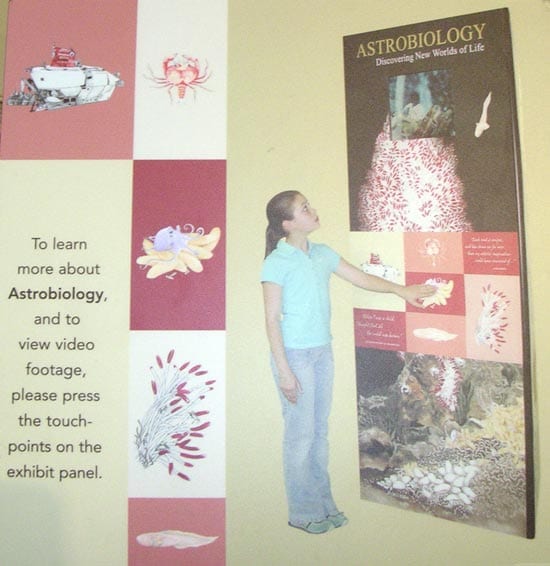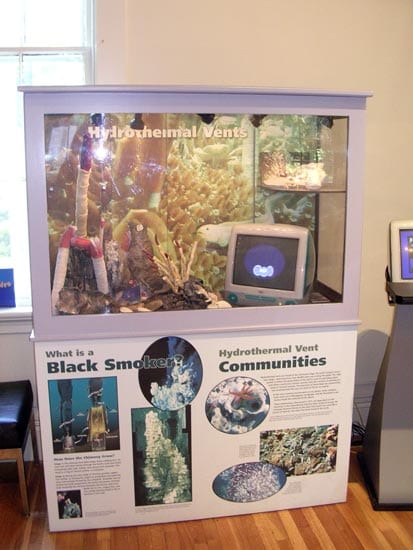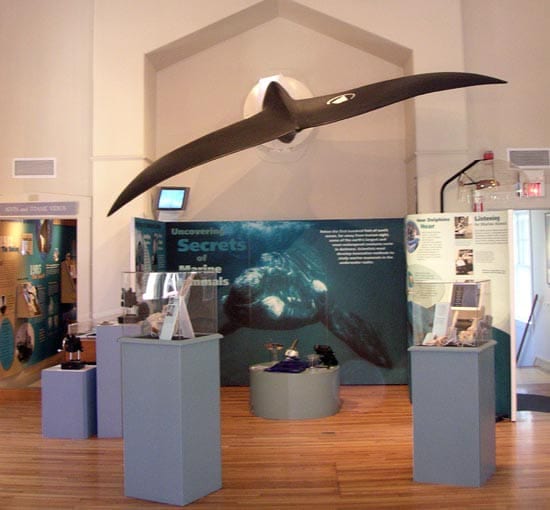Astrobiology Exhibit Visits Woods Hole this Summer
July 28, 2005
Life on Earth and in the universe is the theme of a traveling exhibit on astrobiology at the Woods Hole Oceanographic Institution (WHOI) Exhibit Center during July and August.
The interactive exhibit focuses on clues for understanding how life evolved and its possible existence elsewhere in the universe by understanding present life here on Earth. It uses narration and spectacular videos of life in the deep sea, one of the extreme environments that astrobiologists are exploring. The exhibit features the Institution’s Deep Submersible Alvin and a close look at many of the deep sea creatures living at hydrothermal vents, which were discovered by WHOI scientists and others in 1977.
The NASA Astrobiology Institute (NAI) is a virtual organization of lead teams that study the origin, evolution, distribution, and future of life on Earth and in the universe. One of these teams, led by Mitchell Sogin of the Marine Biological Laboratory (MBL), includes scientists from WHOI, MBL, Brown University and the University of North Carolina at Chapel Hill.
The kiosk exhibit was produced in 2003 by Carnegie Institution of Washington as part of its education and public outreach efforts as a member of NAI. It is available to all members of the NAI scientific and education and public outreach teams to be displayed at conferences, schools, universities, and public lectures, as well as museums, science centers, and libraries for public display on a rotational basis.
The exhibit has been displayed at NAI’s Astrobiology Science Conference in Mountain View, CA, in Ames, Iowa, at the University of Tennessee and Pennsylvania State University, It also toured four of the Hawaiian islands through the efforts of the University of Hawaii Astrobiology team, and was at the NAI National Conference in Boulder, Colorado, in April 2005.
The WHOI Exhibit Center helps visitors learn about ocean sciences research and the vessels and tools developed by Institution engineers and scientists. Current displays include an introductory video about WHOI, exhibits on cores and mud, highlights of the 1985 discovery and the 1986 exploration of the wreck of the Titanic, and marine mammal communications. Visitors can also step inside a full-size model of the inner sphere of Alvin and imagine life at the ocean floor while watching vivid footage taken at deep-sea hydrothermal vent sites.
The Exhibit Center is at 15 School Street in Woods Hole, MA. Visitors can see the astrobiology exhibit and other exhibits Monday through Saturday 10:00 a.m. to 4:30 p.m. and Sundays noon to 4:30 p.m. A donation of $2 per person is suggested for those 10 years of age and older. Groups of 10 or more people are asked to call 508-289-2700 for reservations.
Woods Hole Oceanographic Institution (WHOI) is a private, independent marine research and engineering and higher education organization located in the Town of Falmouth, MA. Its primary mission is to understand the oceans and their interaction with the Earth as a whole, and to communicate a basic understanding of the ocean’s role in the changing global environment. Established in 1930 on a recommendation from the National Academy of Sciences, the Institution operates the U.S. National Deep Submergence Facility that includes the deep-diving submersible Alvin, a fleet of global ranging ships and smaller coastal vessels, and a variety of other tethered and autonomous underwater vehicles. WHOI is organized into five departments, interdisciplinary institutes and a marine policy center, and conducts a joint graduate education program with the Massachusetts Institute of Technology. It is celebrating its 75th anniversary in 2005 with a series of special events.



